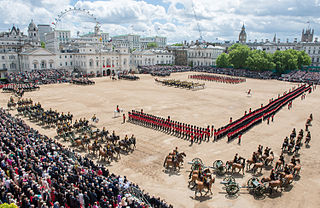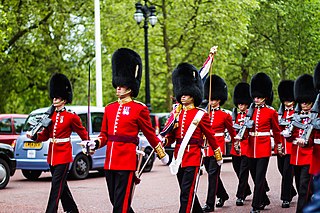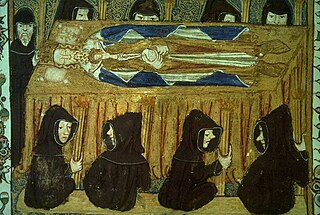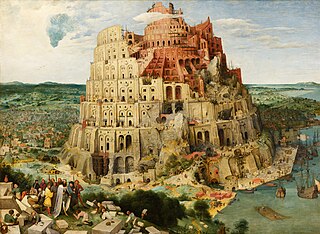
Yeoman is a noun originally referring either to one who owns and cultivates land or to the middle ranks of servants in an English royal or noble household. The term was first documented in mid-14th-century England. The 14th century also witnessed the rise of the yeoman longbow archer during the Hundred Years' War, and the yeoman outlaws celebrated in the Robin Hood ballads. Yeomen also joined the English Navy during the Hundred Years' War as seamen and archers. In the early 15th century, yeoman was the rank of chivalry between page and squire. By the late 17th century, yeoman became a rank in the Royal Navy for the common seamen who were in charge of ship's stores, such as foodstuffs, gunpowder, and sails.

The King's Body Guard of the Yeomen of the Guard is a bodyguard of the British monarch. The oldest British military corps still in existence, it was created by King Henry VII in 1485 after the Battle of Bosworth Field.

Trooping the Colour is a ceremonial event performed every year on Horse Guards Parade in London, United Kingdom, by regiments of Household Division, to celebrate the official birthday of the British sovereign. It is also known as the Sovereign's Birthday Parade. Similar events are held in other countries of the Commonwealth. In the UK, it is, with the State Opening of Parliament, one of the biggest events of the ceremonial calendar, and watched by millions on TV and on the streets of London.

His Majesty's Body Guard of the Honourable Corps of Gentlemen at Arms is a bodyguard to the British Monarch. Until 17 March 1834, they were known as The Honourable Band of Gentlemen Pensioners.

The Royal Company of Archers, The King's Bodyguard for Scotland is a ceremonial unit that serves as the Sovereign's bodyguard in Scotland—a role it has performed since 1822 during the reign of King George IV when the company provided a personal bodyguard to the King on his visit to Scotland. It is currently known as the King's Bodyguard for Scotland or, more often and colloquially, The Royal Company. It is located in Edinburgh, the capital city of Scotland. The Royal Company of Archers has a long history in Scotland as a body that celebrated both the recreation and talent of local archers. As a body established by the Monarch, the company has a long history of unique prizes, influential supporters, and ceremonial roles. It has an associated charity, the Royal Company of Archers Charitable Trust, dedicated to helping disadvantaged individuals with their health and wellbeing in Scotland.

The King's Guard are sentry postings at Buckingham Palace and St James's Palace, organised by the British Army's Household Division. The Household Division also mounts sentry postings at Horse Guards, known as the King's Life Guard.

A royal guard is a group of military bodyguards, soldiers or armed retainers responsible for the protection of a royal family member, such as the emperor or empress, king or queen, or prince or princess. They often are an elite unit of the regular armed forces, or are designated as such, and may maintain special rights or privileges.

Lying in state is the tradition in which the body of a deceased official, such as a head of state, is placed in a state building, either outside or inside a coffin, to allow the public to pay their respects. It traditionally takes place in a major government building of a country, state, or city. While the practice differs among countries, in the United States, a viewing in a location other than a government building, such as a church, may be referred to as lying in repose. It is a more formal and public kind of wake or viewing. Lying in state often precedes a state funeral.
An office created in the Private Secretary's Office of the Royal Household of the Sovereign of the United Kingdom in 2004. The first office-holder was Brigadier Jeffrey Cook, a former Special Air Service (SAS) officer. He served until 2008.
The High Constables of Holyroodhouse are a small corps of ceremonial bodyguards at the Sovereign's official residence in the Scottish capital, Edinburgh. Created in the early sixteenth century to protect the Monarch in residence at Holyrood, as well as to guard the Palace and Abbey, and enforce law and order within the precincts of the Palace and the Holyrood Abbey Sanctuary.
Lords-in-waiting (male) or baronesses-in-waiting (female) are peers who hold office in the Royal Household of the sovereign of the United Kingdom. In the official Court Circular they are styled "Lord in Waiting" or "Baroness in Waiting".
A protective security unit typically provides policing, security, intelligence and bodyguard services for sovereigns and politicians. It can be contrasted with a security service, which provide protective security intelligence such as the British Security Service; and a guards regiment for the defence of the Sovereign and the metropolis. Examples of these include the Household Division.

The Life Guards was the senior formation of the King of France's Household Cavalry within the Maison militaire du roi de France.

The Royal Guard is an independent regiment of the Spanish Armed Forces that is dedicated to the protection of the King of Spain and members of the Spanish royal family. It currently has a strength of 1,500 troops. While the guard does participate in parades and other ceremonial events, it is a fully functional combat unit. Its members are recruited from the ranks of all three branches of the Spanish Armed Forces and receive the same combat training as regular soldiers.

The English Army existed while England was an independent state and was at war with other states, but it was not until the Interregnum and the New Model Army that England acquired a peacetime professional standing army. At the Restoration of the monarchy, Charles II kept a small standing army, formed from elements of the Royalist army in exile and elements of the New Model Army, from which the most senior regular regiments of today's British Army can trace their antecedence. Likewise, Royal Marines can trace their origins back to the formation of the English Army's "Duke of York and Albany's maritime regiment of Foot" at the grounds of the Honourable Artillery Company on 28 October 1664.

The Royal Households of the United Kingdom are the collective departments that support members of the British royal family. Many members of the royal family who undertake public duties have separate households. They vary considerably in size, from the large Royal Household that supports the sovereign to the household of the Prince and Princess of Wales, with fewer members.

The Palace of Holyroodhouse, commonly referred to as Holyrood Palace or Holyroodhouse, is the official residence of the British monarch in Scotland. Located at the bottom of the Royal Mile in Edinburgh, at the opposite end to Edinburgh Castle, Holyroodhouse has served as the principal royal residence in Scotland since the 16th century, and is a setting for state occasions and official entertaining.

The Yeomen Warders of His Majesty's Royal Palace and Fortress the Tower of London, and Members of the Sovereign's Body Guard of the Yeoman Guard Extraordinary, popularly known as the Beefeaters, are ceremonial guardians of the Tower of London. In principle they are responsible for looking after any prisoners in the Tower and safeguarding the British crown jewels. They have also conducted guided tours of the Tower since the Victorian era.

The Monteros de Espinosa are the oldest Bodyguard unit of Royal Guards in Europe. They were founded by the Counts of Castile around the year 1006 and kept in service by the Castilian Sovereigns and posterior Dynasties that inherited their Kingdoms and united with. It is still part of the Spanish Guardia Real.
The High Constables of Edinburgh are a prestigious body of constables, founded in 1611 and located in Edinburgh, Scotland. Historically, the High Constables were charged with policing the streets of Edinburgh, the capital city of Scotland, however today their duties are mostly ceremonial. It is believed that the High Constables of Edinburgh are the first example of a statutory police force in the world. At one time they formed part of the now defunct Corporation of the City of Edinburgh and continue to serve a ceremonial function in the local government of Edinburgh.















